I designed my own curriculum for high school English based on lists of classic literature, life skills to acquire, and writing projects to enjoy. Literature and writing are two of my favorite subjects to teach and all my children have come to love them, too!
“What do you cover in English during high school?” I am often asked by homeschool moms when I speak at homeschool conventions.
“What curriculum did you use for English?” is another question that I hear often.
I had to admit that I created all my high school English courses and explain why. One of the reasons I created my own high school English classes is that I wanted my children to enjoy literature and writing.
Yes, I did say ‘enjoy’. I wanted my teens to read classic literature that was fun to read and had stood the test of time. I wanted my young adults to learn certain writing skills like using original sources, writing a research paper, creating an excellent essay, dabbling a bit in poetry, and writing a novel. I also wanted them to give speeches. Wow! That’s a lot of stuff!
We discuss all literature in a book club setting. I might be just my teen and me with some hot chocolate and cookies. Or it might be a small group of friends. We also use book clubs in homeschool co-ops.
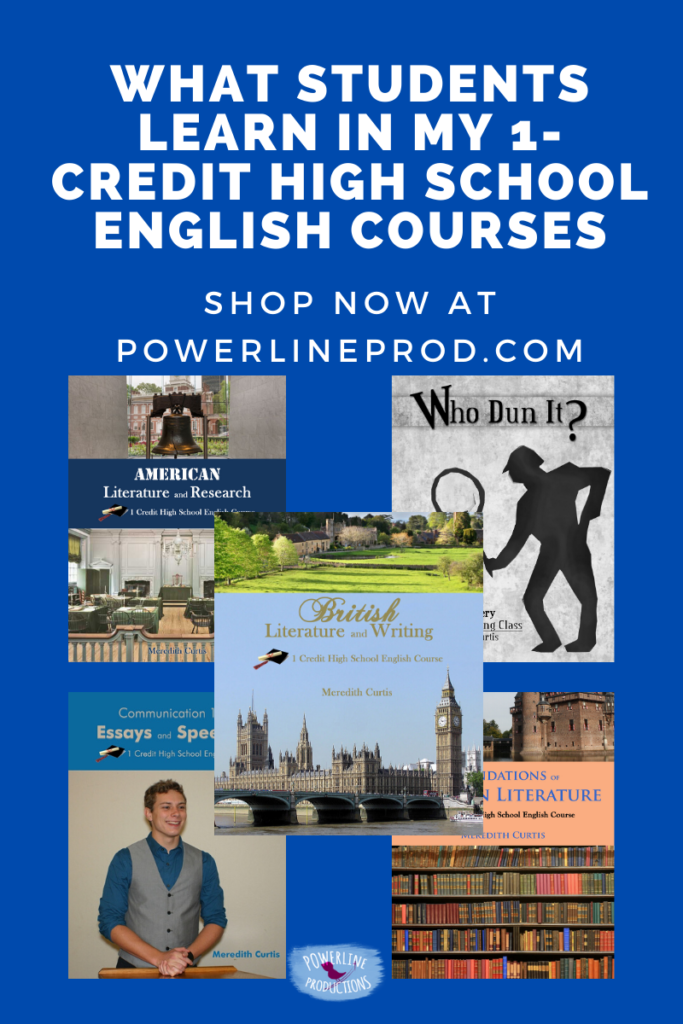
You can put together your own high school English courses, too. More on that in another blog. But for right now, I’ll just tell you what I taught in each English course.
First of all, I should add that I gave my children five years of high school English, starting in eighth grade. These courses were all self-contained and didn’t have to go in a specific order. That way, siblings could take courses together.
Are you ready? Here’s what I taught in each English course. Keep in mind that all of these course have been taught in a homeschool co-op and individually at home.
There is no specific order they need to be taught in.
Essays, Speeches, & Literature
The purpose my Communications 101: Essays and Speeches course is to read classic essays and write excellent essays, as well as listen to excellent speeches and give speeches in a positive environment.
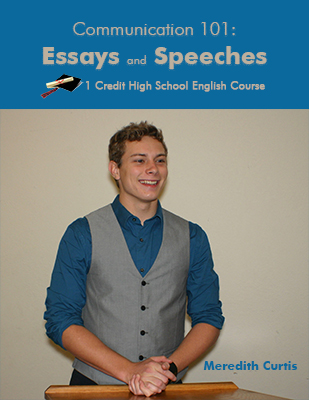
Each month we read a classic essay, look up vocabulary words from that essay, and discuss it together. We also read one book a month.
The classic essays we read were written by C.S. Lewis, G.K. Chesterton, Mark Twain, Charles Lamb, Sir Frances Bacon, Cal Thomas, and William F. Buckley.
We read God in the Dock, Ivanhoe, The Screwtape Letters, The Prince and the Pauper, Around the World in 80 Days, The Mysterious Island, A Connecticut Yankee in King Arthur’s Court, and Time Machine.
Note: We need an audience for speeches when we do this course individually so we invite another family over. Between the two families, there is a decent-sized audience.
We work on thesis statements and learn to use the thesis statement to guide an essay. Then we write the following essays: Descriptive, Narrative, Article, Letter to the Editor, Persuasive, Comparative, and Book Review.
We listen to excellent speeches by Ronald Reagan, Martin Luther King, Winston Churchill, John F. Kennedy, Douglas MacArthur, and speeches from movies on YouTube. This is great for noticing what good speakers do. We discuss what we watch.
My teens give the following speeches: Reading Aloud, Introduction of Self, Demonstration, Personal Testimony, Persuasive, Commercial, Interview, and Extemporaneous. We also do two weeks of debate to just get a taste of it. We create a safe and positive environment for giving speeches to build confidence in speaking in front of a group.
Classic American Literature with Step-by-Step Research Skills & Paper
The purpose of American Literature and Research is two-fold: to read classic American literature and to learn all the skills needed to research and write a research paper, including using primary sources. I almost always taught this course while I was teaching American history, but if it doesn’t fall on that year, I give my kids a spattering of American history and we read the literature in chronological order.
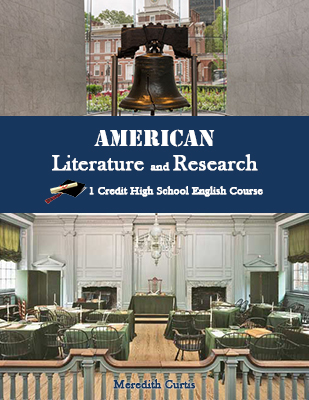
Sometimes, my teens have just chosen a certain number of books to read from my list of American literature. Other times, we read the following books in chronological order: Plimoth Plantation, Brief Narrative of the Progress of the Gospel (john Eliot), Diary of David Brainerd, Narrative of the Captivity and Restoration of Mary Rowlandson, Autobiography of Ben Franklin, The Deer Slayer, The Scarlet Letter, 6 of the Federalist Papers, 6 of the Anti-Federalist Papers, A Narrative of the Life of Davy Crockett, “The Tell-Tale Heart,” “Diary of Adam & Eve,” “Bartleby the Scrivener,” Uncle Tom’s Cabin, Ben Hur, In His Steps, “Should America Intercede for the Jews,” Up From Slavery, The Old Man and the Sea, To Kill a Mockingbird, Peanuts Cartoons, Tilly, and The Giver.
We also read aloud: “Day of Doom” (popular poem in Colonial Times), “Sinners in the Hands of an Angry God,” “Give Me Liberty or Give Me Death,” “Booze” Sermon, and “Our Town” scene (play).
We discuss everything we read in book club, relaxing and digesting the book together.
At the beginning of the year, we learn to paraphrase and summarize, working with writings from Colonial Times by Cotton Mather, Ben Franklin, and other primary sources. Working with primary sources from the Age of Reason is a challenge, but we work together and by the time, we are ending that segment, the kids are able to working easily with these writings.
From there, we move on to creating a thesis statement from a genuine question. Around this time, we write a letter to the editor, an article, and an essay.
Starting in January, we begin the process of researching and writing a research paper step-by-step, starting with a trip to the library. We move forward by discussing and evaluating every part of the process so that no one is writing the entire paper at three in the morning.
Classic British Literature with a Variety of Creative writing
Classic British literature is amazing and we savor these great works by Dickens, Austen, Carroll, Milton, Bunyan, Doyle, Lewis, Spurgeon, Sayers, and Christie. Our writing assignments are eclectic this year, based on the works we read. We read books in chronological order and go over a brief summary of British literature each month in British Literature & Writing.
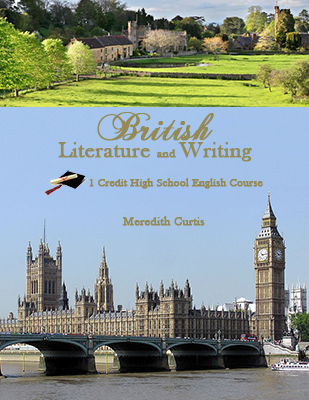
We read the following novels: Beowulf, Pilgrim’s Progress, Paradise Lost, Robinson Crusoe, Pride and Prejudice, Tale of Two Cities (or A Christmas Carol for younger students), Alice in Wonderland, Strange Case of Dr. Jekyll and Mr. Hyde, The Hound of the Baskervilles, Perelandra, and The Mysterious Affair at Styles. We also read the following works: “The Second Nun’s Tale” from Canterbury Tales, “A Bachelor’s Complaint about the Behavior of Married People,” “The Old Manse and the Meeting House Stambourne,” and “Lost Tools of Learning.”
We read the following works aloud together: “Romeo and Juliet” Act I Scene II and poetry from Shakespeare and Victorian poets.
Teens write several papers, modeling after the classics they read. After Beowulf, they write an epic poem, after “A Second Nun’s Tale,” they write Isreal Tales, and after reading Shakespeare’s sonnet, they write their own sonnet. They also write essays, a Victorian poem, and an allegory.
Ancient Literature to Middle Ages with Literary Analysis
The purpose of Foundations of Western Literature is to go way back in time to read classics from Western culture and to learn to analyze literature. This is the only course where we write papers about literature in addition to book club discussions.
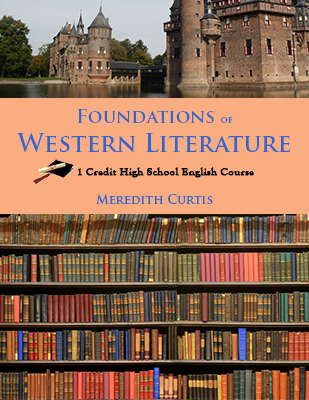
This is also the only course where we use paraphrases for some of the books. Why? Well, some ancient literature is dirty. Surprised? Don’t be. Ancient Babylonian, Greek, and Roman writers were not followers of the True God and had a whole different set of morals. Instead of Beowufl, we read Gilgamesh the Hero. Instead of The Odyssey, The Iliad, and The AEneid, we read those stories by A.G. Church, an American pastor in the 1800s. These books are well-written and the story is not simplified. We also read D’Aulaires’ Book of Norse Myths instead of the original Norse Myths.
Aside from these classics, we read three books in The Holy Bible: Genesis, Matthew, and Acts. We also read The Art of War (China), Aesop’s Fables, Adam and His Kin, Rhetoric (Aristotle), Plutarch’s Lives, City of God, 1001 Arabian Nights, Pliny the Younger’s Description of The Eruption of Mount Vesuvius, Jack London’s Description of the San Francisco Earthquake The Merry Adventures of Robin Hood, Grimm’s Fairy Tales, and Fairy Tales by Hans Christian Andersen. We also read “Song of Roland” aloud.
Throughout the course, we talk about how the themes of these classics show up over and over again in movies, TV, and books. We also spend time discussing each work, asking questions, and brainstorming.
We start with basic analysis and build up to writing a literary analysis on a character in The Merry Adventures of Robin Hood. The teens write the following papers: Plot Evaluation, My Character in The Odyssey, Theme Analysis, Commercial Rhetoric Analysis Project, God’s Love in “The Prodigal Son” Essay, Parallel Lives Biographies, Comparison Essay (comparing written descriptions), Blog Post, Characterization Analysis, and Fairy Tale.
How to Write a Novel With Classic Literature
I thought it would be exciting for each of my children to write their own novel in high school. Just for the fun of it. So, I decided to devote an entire year to writing a novel. We would read literature with great characters, plots, and settings while we put on our author’s cap. I had no idea how beneficial it would be for their understanding of literature. Once you write your own plot, you notice plot so much more – the inciting incident, rising action, climax, and resolution. You recognize how authors create characters and introduce them through dialogue, behavior, and what others characters think and say – because you do it!
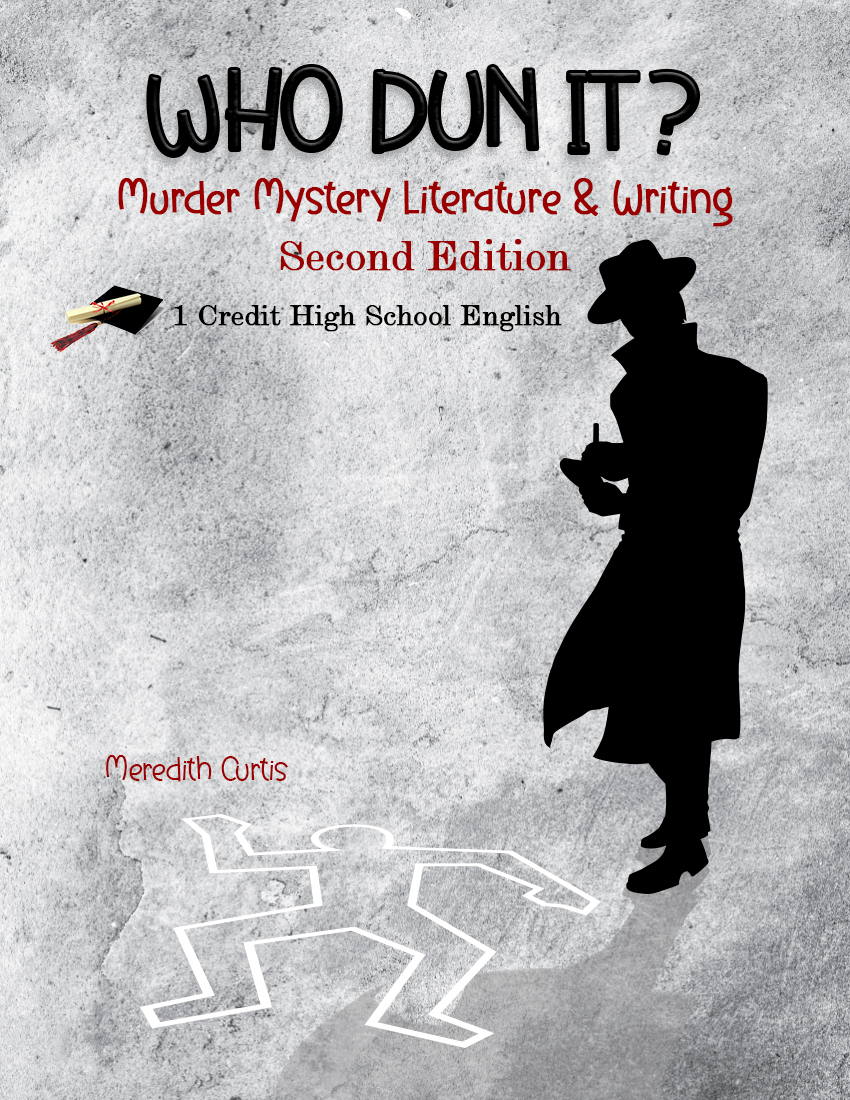
Anyway, we have used different curricula, but when it’s was my third daughter’s turn, I had a great idea. We both loved mysteries so I would create a course where we could write our own Who Dun It. With Who Dun It Murder Mystery Literature & Writing, we had a blast creating characters, plot lines, settings, and dialogues. After a successful year, I ended up teaching this course several times to the rest of my children and in homeschool co-ops. It is a favorite!
We read classic, or Golden Age, murder mysteries by amazing authors likes G.K Chesterton, Agatha Christie, Sir Conan Doyle, A. A. Milne (yes, he wrote one!), Ellery Queen, Dorothy Sayers, E.C. Bentley, and H.C. Bailey. We also took a few weeks to read children’s mysteries like Nancy Drew, Trixie Belden, Sugar Creek Gang, Hardy Boys, and Encyclopedia Brown. We also watched classic TV shows like Perry Mason.
We spend the first half of the year creating detectives, sidekicks, clues, red herrings, hooks, scenes, and plot twists. We also write a short story. During the second half of the year, we write our novel. Each week throughout the entire year, we spend a lot of time discussing, brainstorming, and giving input to one another. If we don’t have an additional person or group taking the course, I write a novel, too, so we can give each other input.
How about Grammar?
Do I teach grammar in high school?
No. We just review.
We did grammar every year from third grade to seventh grade. Then we were done! We use Daily Grams, one page per week so they won’t forget their grammar skills in high school. Believe me, grammar and spelling come up a lot as we write papers.
My English Courses are Available for You!
I hope I have inspired you to create your own English course for high school.
I have had many people ask about how I teach English and what I teach in each course, so I have packaged each course for those who want to use my courses in their home school.
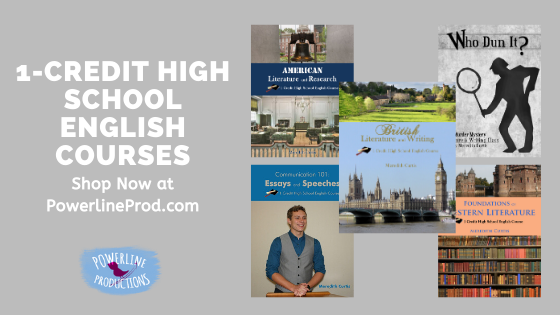
- You can purchase all my high school English courses online in print at Amazon or digital eBooks at PowerlineProd.
- Learn more about Communication 101: Essays & Speeches HERE!
- Learn more about American Literature & Research HERE!
- Learn more about British Literature & Writing HERE!
- Learn more about Foundations of Western Literature HERE!
- Learn more about Who Dun It: Murder Mystery Literature & Writing HERE!
- You can purchase all of our one-credit high school course HERE!
Until next time, Happy Homeschooling!
Warmly,
Meredith Curtis
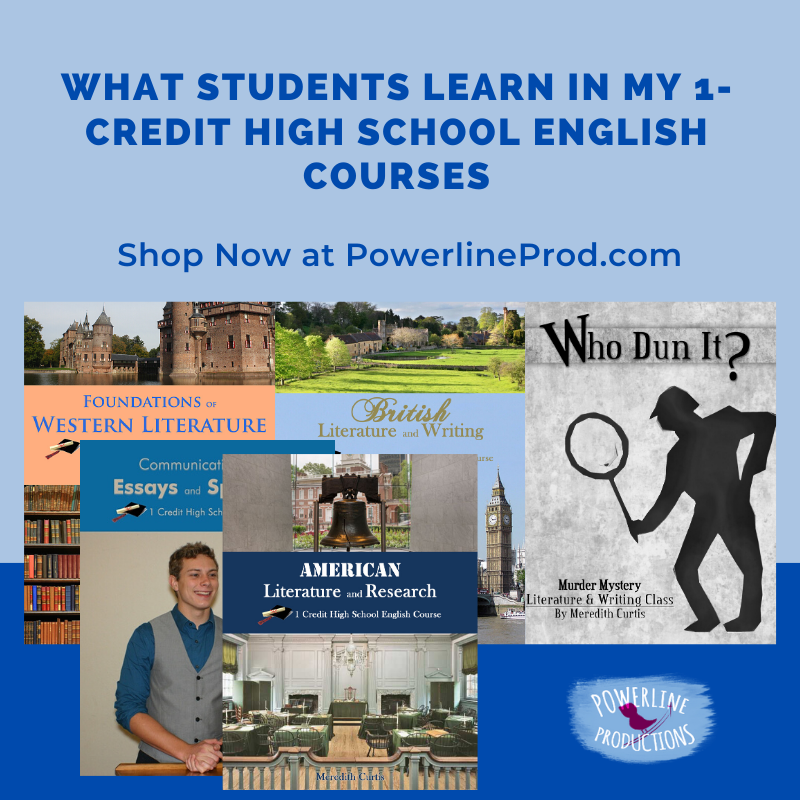

1 Comment